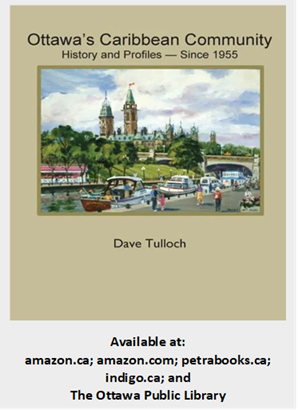
Book Review: Ottawa’s Caribbean Community History and Profiles – Since 1955
Publishers: Petrabooks (https://www.petrabooks.ca/)
By Olivia Barrett, Editorial Associate
Friday 20 October, 2023
The lasting influence of Ottawa’s first Caribbean immigrants: Dave Tulloch’s Ottawa’s Caribbean Community History and Profiles – Since 1955
When I first started reading Dave Tulloch’s Ottawa’s Caribbean Community History and Profiles – Since 1955, I wasn’t sure what to expect. Looking around Ottawa today and seeing small pockets of Caribbean culture, I didn’t think these roots have been growing in the nation’s capital for over 50 years – in some cases, for nearly a century.
This book was shocking, heartwarming, somber and everything in between.
The message of the book was clear despite the emotions evoked in each part: Caribbean culture touched every single part of the Ottawa community and Canada at large.
Through learning about these histories, readers are able to further understand Ottawa’s history. Caribbean immigrants touched every part of Ottawa from studying at the same institutions as students today to restaurants to music and more.
Despite Ottawa being a smaller city with an even smaller Black population, the first immigrants who set up in the city had a similar motivation for coming here: to better themselves. As a result of this motivation, Caribbean immigrants were able to cultivate a sense of belonging within each other and share this culture both with their own community and with the larger Ottawa community.
Before getting into the impact these first immigrants had on the city, Tulloch explored the history of immigration policies and gave an overall view of the cultural, historical and socio-economic relationship between Canada and Caribbean immigrants.
Tulloch explains the different waves of immigration policies that at times increased immigration from the Caribbean and at other times outright halted it. In spite of these changes, the roots of Caribbean culture continued to grow across Canada and right here within the nation’s capital.
As Tulloch says on page 48 of this book, “anything authentic to the Caribbean was to be found only in the hearts and minds of the early immigrants to the City of Ottawa.”
In addition to the more widely documented history, Tulloch discusses the lesser-known history of Black people in Canada. He even explains that the reason behind this history not being associated with Canada or documented in Canadian history is because slavery in Canada happened prior to Confederation.
By using the first part of this book to explain the complex history between Canada and Caribbean immigrants, Tulloch also has descriptions of pillars in the community. By explaining these things, like the Flamingoes band in the 1970s, it allowed him to focus in the profiles without needing to add lengthy descriptions for clarification. This made reading the book very easy and helped the profiles flow naturally as they described these leaders within Ottawa’s Caribbean community.
In the profile section of the book, Tulloch touches on all aspects of life in Ottawa for Caribbean immigrants such as education, hobbies, community associations, food and more. Tulloch profiles leaders within business and commerce, academic, religion, health care, media, law, science and several other pivotal members of the community like Jean Augustine and other politicians who spent time in the nation’s capital.
Tulloch explores the lasting impacts some of these leaders had on Ottawa and the country as a whole. For example, he profiles Ewart Walters who started The Spectrum, Ottawa’s first Black newspaper, and Hugh Fraser who made the Ontario government make a crucial change the ‘Power of Attorney’ Act. This change stated that ““as long as you were of sound mind when you appointed that person it cannot be revoked,” which was an important change for people diagnosed with Alzheimer’s and similar diseases.
Throughout the book, Tulloch explains how the documentation of Caribbean immigrants in Ottawa was not easily found. He discusses how immigration policies like the Domestic Worker Scheme did not always keep thorough records of the women who came over during this time.
As a result of this, it was surprising to me as a reader that Tulloch was able to find this amount of information on the Caribbean community during this time.
While reading this history was surprising in itself, learning about how deeply engrained the impact of Caribbean immigrants is on the city of Ottawa and Canada was healing.
At the end of the book, Tulloch included an epilogue by his youngest daughter Melanie Tulloch. She reflects on her experience growing up without this type of history being taught in school and how the exposure to this history from her family encouraged her to keep learning more about it.
As she says in the epilogue, “it is also equally important to tell both sides of the story – that is our struggle, but also the amazing accomplishments we’ve had.”
While reflecting on her experience growing up without this history, Melanie discusses how she felt growing up with limited Black representation and not always having a sense of belonging around others in her classes.
This is the history we were not taught in school. This is the sense of belonging Caribbean children have been longing for, compiled into one cohesive, informational and heartening book.
As Melanie Tulloch says in the epilogue, “this is why representation matters.”
Editor: Dave Tulloch’s book is available from the publishers at: Petrabooks https://www.petrabooks.ca/ , and at Amazon https://www.amazon.ca/.
